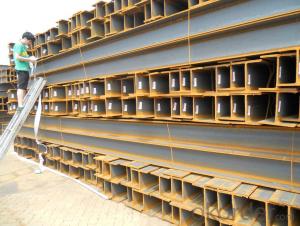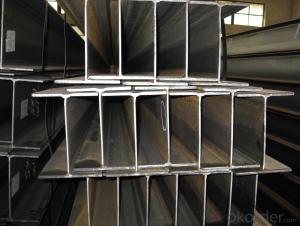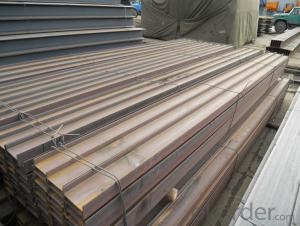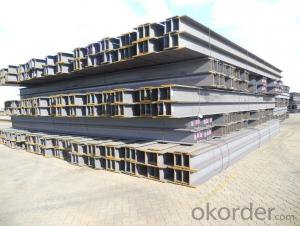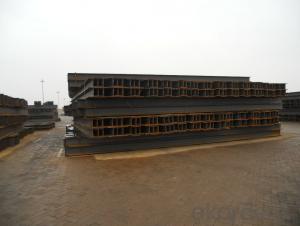JIS Standard SS400 H beams with Good Quality 340mm-396mm
- Loading Port:
- Tianjin
- Payment Terms:
- TT or LC
- Min Order Qty:
- 100 m.t
- Supply Capability:
- 15000 m.t/month
OKorder Service Pledge
OKorder Financial Service
You Might Also Like
Specifications of JIS Standard SS400 H beams with Good Quality 340mm-396mm:
1. Standard: JIS 3192
2. Grade: SS400 or Equivalent
3. Length: 10m, 12m as following table
4. Invoicing on theoretical weight or actual weight as customer request
5.Payment: TT or L/C
Size and Mass of JIS Standard SS400 H beams with Good Quality 340mm-396mm:
| Size (mm) | Mass (Kg/m) | Size (mm) | Mass (Kg) |
| 340*250*9.0 | 78.1 | 350*350*12.0 | 135 |
| 344*348*10.0 | 113 | 396*199*7.0 | 56.1 |
Packaging & Delivery of JIS Standard SS400 H beams with Good Quality 340mm-396mm for Building Structures:
1. Packing: it is nude packed in bundles by steel wire rod
2. Bundle weight: not more than 3.5MT for bulk vessel; less than 3 MT for container load
3. Transportation: the goods are delivered by truck from mill to loading port, the maximum quantity can be loaded is around 40MTs by each truc4. If the order quantity cannot reach the full truck loaded, the transportation cost per ton will be little higher than full load.
4. Delivered by container or bulk vessel
Usage of JIS Standard SS400 H beams with Good Quality 340mm-396mm:
(1). for the plant, high-rise building construction
(2). for the bridge, shipment building
(3).for lifting and transportation machinery, equipment manufacturing base building
(4). for the support, foundation pile manufacturing
FAQ:
Q1: Why buy Materials & Equipment from OKorder.com?
A1: All products offered by OKorder.com are carefully selected from China's most reliable manufacturing enterprises. Through its ISO certifications, OKorder.com adheres to the highest standards and a commitment to supply chain safety and customer satisfaction.
Q2: How do we guarantee the quality of our products?
A2: We have established an advanced quality management system which conducts strict quality tests at every step, from raw materials to the final product. At the same time, we provide extensive follow-up service assurances as required.
Q3: How soon can we receive the product after purchase?
A3: Within three days of placing an order, we will arrange production. The shipping date is dependent upon the quatity, how many sizes you want and the plan of production, but is typically 1 month to 2 months days from the beginning of production.
Images of JIS Standard SS400 H beams with Good Quality 340mm-396mm:


* If you would like to get our price, please inform us the size, standard/material and quantity. Thank you very much for your attention.
- Q:What are the different corrosion protection methods for steel H-beams?
- There are several corrosion protection methods for steel H-beams, including galvanization, painting, epoxy coatings, and metalizing.
- Q:Can steel H-beams be used in the construction of hospitals or healthcare facilities?
- Yes, hospitals or healthcare facilities can make use of steel H-beams in their construction. Steel H-beams are extensively used in the field of construction due to their robustness, longevity, and adaptability. They provide exceptional structural support and are commonly employed in the construction of sizable edifices, including hospitals and healthcare facilities. In healthcare facilities, the utmost importance is placed on structural integrity and safety, both of which are met by steel H-beams. They possess the ability to endure heavy loads and bestow stability upon the building, thus ensuring the safety of patients, staff, and equipment. Steel H-beams also possess a remarkable resistance to fire and are non-combustible, a vital characteristic for the safety of healthcare facilities. Furthermore, steel H-beams offer a plenitude of design options. They can be effortlessly customized to meet specific architectural requirements and can support various types of roofing, flooring, and wall systems. This versatility allows for efficient space planning and the creation of larger open areas, often necessary in healthcare facilities to accommodate medical equipment, patient rooms, and specialized areas such as operating rooms and laboratories. Additionally, steel H-beams boast an extended lifespan and necessitate minimal maintenance. They are impervious to corrosion, pests, and decay, making them a dependable choice for healthcare facilities that need to remain operational over an extended duration. In conclusion, the strength, durability, safety features, design flexibility, and low maintenance requirements of steel H-beams make them an ideal choice for the construction of hospitals and healthcare facilities.
- Q:Can steel H-beams be painted or coated?
- Steel H-beams are capable of being painted or coated in order to protect them from corrosion, enhance their appearance, and increase their durability against damage. To ensure optimal adhesion, it is crucial to thoroughly clean and prepare the surface prior to painting or coating. The appropriate choice of paint or coating will vary depending on factors like environmental conditions and desired finish. It is advisable to seek advice from a professional or adhere to the manufacturer's instructions to guarantee the proper selection and application of the paint or coating.
- Q:What are the different types of steel H-beam connections used in healthcare facilities?
- Healthcare facilities commonly use various types of steel H-beam connections to ensure the building's structural integrity and safety. These connections not only offer support but also withstand the dynamic loads and vibrations associated with healthcare operations. Some of the steel H-beam connections used in healthcare facilities include the following: 1. Welded connections: The most frequently used connection type in healthcare facilities involves welding the steel H-beams together, creating a strong and rigid connection. Welded connections are often utilized in areas requiring high load-bearing capacity, such as operating rooms or intensive care units. 2. Bolted connections: Bolted connections involve using bolts and nuts to join the steel H-beams together. This connection type allows for easier installation, inspection, and maintenance. Bolted connections are commonly found in non-critical areas of healthcare facilities, like corridors or administrative offices. 3. Moment connections: Designed to resist both vertical and horizontal forces, moment connections provide increased stability and rigidity to the structure. They are often used in areas subjected to lateral loads, such as emergency departments or MRI rooms. 4. Shear connections: Primarily used to transfer lateral loads between steel H-beams, shear connections resist shear forces and prevent beams from sliding or separating. Shear connections are typically employed in areas exposed to wind or seismic loads, like outpatient clinics or radiology departments. 5. Pinned connections: Pinned connections allow for rotation between steel H-beams. These connections are commonly used in areas where structural movements or deflections are expected, such as rehabilitation centers or physical therapy rooms. Pinned connections provide flexibility, allowing the structure to accommodate loads and movements without excessive stress. It is important to note that the selection of steel H-beam connections in healthcare facilities depends on factors such as specific building requirements, load conditions, and local building codes. Consulting structural engineers and architects during the design and construction process ensures appropriate selection and installation of the most suitable connections for healthcare facility structures.
- Q:Light thin-walled H steel, in addition to welding, is there any hot rolling?
- Is the big Hebei Jinxi, Shandong sunshine, other mills some specifications such as Tangshan Shengda, Anshan Bao steel smelting, etc.
- Q:What are the considerations for selecting the appropriate spacing of steel H-beams?
- When selecting the appropriate spacing of steel H-beams, there are several considerations to take into account. Firstly, the load-bearing capacity of the beams must be considered in relation to the anticipated loads and forces they will be subjected to. This includes both the dead loads (the weight of the structure itself) and live loads (such as the weight of occupants, furniture, or equipment). Secondly, the span of the beams plays a crucial role in determining the spacing. Longer spans typically require closer spacing to ensure sufficient support and prevent excessive deflection or sagging. Additionally, the type and thickness of the floor or roof system being supported should be considered in conjunction with the beam spacing to ensure adequate structural integrity. Furthermore, local building codes and regulations may stipulate specific requirements for beam spacing based on factors like building height, occupancy type, and seismic considerations. It is important to adhere to these guidelines to ensure compliance and safety. Lastly, cost and efficiency considerations should also be taken into account. Optimizing the spacing of steel H-beams can help minimize material use, reduce construction costs, and streamline the overall structural design. Overall, when selecting the appropriate spacing of steel H-beams, it is crucial to consider the load-bearing capacity, span, floor or roof system, building codes, and cost-efficiency factors to ensure a safe and structurally sound construction.
- Q:How do steel H-beams perform in high-temperature environments such as industrial furnaces?
- High-temperature environments, such as industrial furnaces, are well-suited for the performance of steel H-beams. Their exceptional thermal conductivity and high melting point are the primary factors contributing to this. These H-beams are typically constructed using structural steel, which is specifically designed to endure elevated temperatures without experiencing notable strength loss or compromised structural integrity. In such high-temperature conditions, steel H-beams effectively and rapidly distribute heat uniformly, thereby minimizing the chances of localized overheating. This plays a crucial role in averting any deformation or failure of the beams, ensuring the overall stability and safety of the structure. Moreover, steel H-beams possess a remarkable melting point, typically around 1370°C (2500°F) for carbon steel. This characteristic allows them to endure extreme heat without incurring significant damage. Even in the most intensely heated regions of an industrial furnace, where temperatures can surpass 1000°C (1832°F), steel H-beams remain structurally sound. Additionally, steel H-beams exhibit outstanding fire resistance properties. They do not combust or contribute to the propagation of fire, making them a reliable choice for high-temperature environments. This attribute is of particular significance in industrial furnaces, where the risk of fire is a considerable concern. All in all, steel H-beams are a suitable option for high-temperature environments like industrial furnaces. Their thermal conductivity, high melting point, and fire resistance properties enable them to withstand extreme heat while maintaining their structural integrity and ensuring safety.
- Q:Can steel H-beams be used for exhibition halls or convention centers?
- Yes, steel H-beams can be used for exhibition halls or convention centers. Steel H-beams are commonly used in construction due to their high strength and durability. They provide structural support and can withstand heavy loads, making them suitable for large and open spaces like exhibition halls or convention centers. Additionally, steel H-beams can be easily fabricated and customized to meet specific design requirements and can be used to create large-span structures without the need for excessive columns or supports. Overall, steel H-beams are a popular choice for building exhibition halls or convention centers as they offer strength, flexibility, and cost-effectiveness.
- Q:What are the load distribution characteristics of steel H-beams?
- The shape and design of the beam primarily determine the load distribution characteristics of steel H-beams. H-beams, which are also referred to as I-beams or W-beams, possess a unique cross-sectional shape consisting of two flanges connected by a web. This shape allows for efficient weight distribution along the beam's length and provides outstanding load-bearing capabilities. Supporting heavy loads over long spans is one of the significant load distribution characteristics of steel H-beams. The flanges, located at the top and bottom of the beam, are specifically designed to resist bending and twisting forces. As a result, the beam can carry substantial loads without deflecting excessively. The ratio of the flange width to the web depth also influences the load distribution along an H-beam. A wider flange width in comparison to the web depth leads to a more evenly distributed load, as the flanges are better equipped to withstand lateral forces. Conversely, a narrower flange width relative to the web depth concentrates the load towards the center of the beam. Furthermore, the load distribution characteristics of H-beams can be altered by adjusting the beam's dimensions and material properties. Engineers can customize the load distribution capabilities of H-beams by varying parameters such as flange thickness, web height, and steel grade to meet specific structural requirements. In summary, steel H-beams are renowned for their exceptional load distribution characteristics, making them a sought-after choice in construction and engineering applications that necessitate robust, long-lasting, and efficient load-bearing capabilities.
- Q:Can steel H-beams be used for supporting conveyor systems?
- Indeed, steel H-beams possess the ability to support conveyor systems. In construction and industrial domains, these H-beams are widely utilized owing to their exceptional strength and durability. They offer unparalleled assistance in bearing heavy loads and can endure the weight and vibrations inherent in conveyor systems. Moreover, their structure facilitates effortless attachment of other essential components and accessories necessary for conveyor installation. Nevertheless, it is crucial to ascertain that the chosen steel H-beam satisfies the prescribed load-bearing capacity and is appropriately engineered and installed to guarantee the safety and steadfastness of the conveyor system.
1. Manufacturer Overview |
|
|---|---|
| Location | |
| Year Established | |
| Annual Output Value | |
| Main Markets | |
| Company Certifications | |
2. Manufacturer Certificates |
|
|---|---|
| a) Certification Name | |
| Range | |
| Reference | |
| Validity Period | |
3. Manufacturer Capability |
|
|---|---|
| a)Trade Capacity | |
| Nearest Port | |
| Export Percentage | |
| No.of Employees in Trade Department | |
| Language Spoken: | |
| b)Factory Information | |
| Factory Size: | |
| No. of Production Lines | |
| Contract Manufacturing | |
| Product Price Range | |
Send your message to us
JIS Standard SS400 H beams with Good Quality 340mm-396mm
- Loading Port:
- Tianjin
- Payment Terms:
- TT or LC
- Min Order Qty:
- 100 m.t
- Supply Capability:
- 15000 m.t/month
OKorder Service Pledge
OKorder Financial Service
Similar products
New products
Hot products
Related keywords
